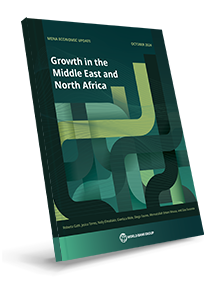Algeria | Bahrain | Djibouti | Egypt | Iran | Iraq | Jordan | Kuwait | Lebanon | Libya | Morocco | Oman | Palestinian Territories | Qatar | Saudi Arabia | Syria | Tunisia | United Arab Emirates | Yemen
Country Profiles
Chapters
Macroeconomic Outlook
In Chapter 2 of the report, World Bank economists forecast that the Middle East and North Africa (MENA) will grow at a modest rate of 2.2% in 2024. This slight uptick in growth from 2023 masks disparities between high-income oil exporters and other developing economies in the region. 2024 real GDP growth forecasts have been substantially downgraded, partly reflecting the high level of uncertainty in the region amid the ongoing conflict in Gaza and the potential for widening of the conflict in neighboring countries.
Conflict
This latest edition of the MENA Economic Update (MEU) examines the impact the conflict is having on the Palestinian economy. In Chapter 3, World Bank economists estimate that the economy of Gaza has come to a near total halt, with a staggering 86 percent contraction in real GDP. In the West Bank, the economy also contracted by 23 percent. The report underscores how the conflict has affected the rest of the MENA region as well as the global economy.
Growth
The authors delve into an analysis of the factors that shape MENA’s long-term growth potential across chapters 4 and 5. In chapter 4, the report looks at the long-term costs of conflict in a region where both the frequency and the severity of conflicts has increased. Then, in chapter 5, the report examines the levers that countries can employ to accelerate growth including increasing female labor force participation rates, reallocating talent from the public to the private sector, and leveraging geography to access knowledge, innovation, and technology through increased international trade.
While the MENA region is currently lagging behind, the report identifies windows of opportunity to strengthen growth and achieve a more prosperous future.





